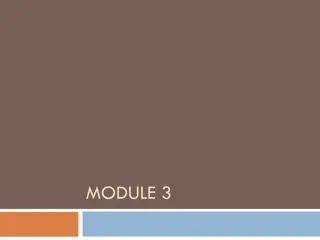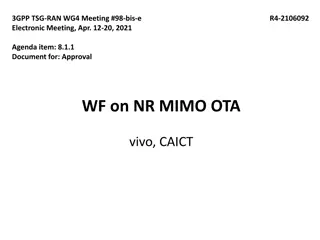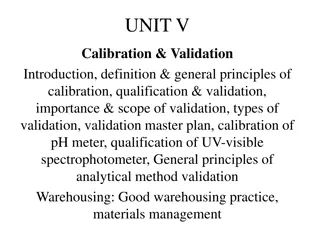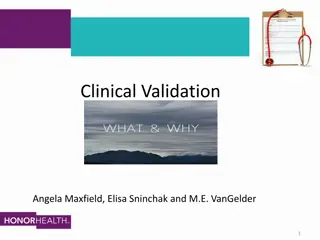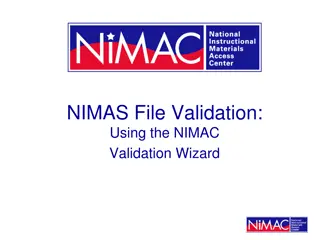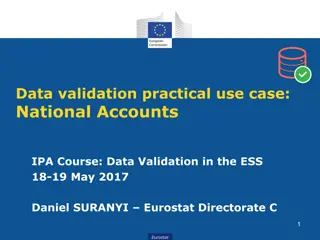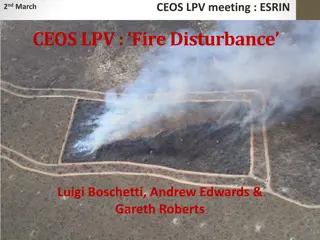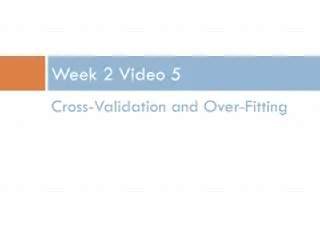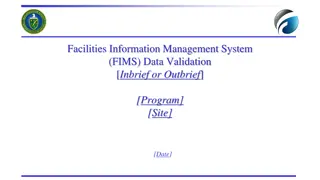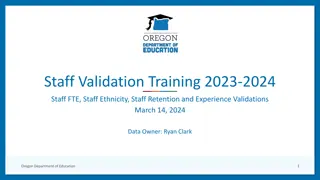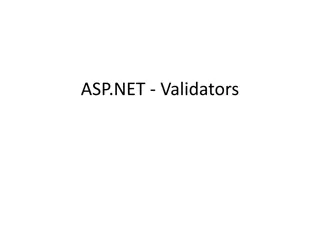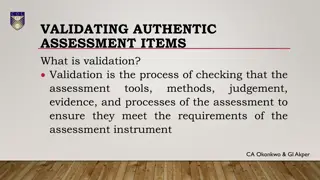Insights from CCMC-Led Model Validation Challenges & International Coordination
Explore lessons learned from CCMC-led community-wide model validation challenges, emphasizing the importance of international coordination for monitoring and validation activities in the space weather domain. Discover key elements of model validation, community-wide metrics studies, and operational geospace model validation efforts for SWPC.
Download Presentation

Please find below an Image/Link to download the presentation.
The content on the website is provided AS IS for your information and personal use only. It may not be sold, licensed, or shared on other websites without obtaining consent from the author.If you encounter any issues during the download, it is possible that the publisher has removed the file from their server.
You are allowed to download the files provided on this website for personal or commercial use, subject to the condition that they are used lawfully. All files are the property of their respective owners.
The content on the website is provided AS IS for your information and personal use only. It may not be sold, licensed, or shared on other websites without obtaining consent from the author.
E N D
Presentation Transcript
Lessons learned from CCMC-led community-wide Model Validation Challenges. Outlook on international coordination of M&V activities. M. Kuznetsova, M. L. Mays, C. Wiegand, A. Pulkkinen, L. Rastaetter, J-S. Shim, M. Maddox MODELS DATA TOOLS SYSTEMS SERVICES DATABASES
CCMC Assets & Services Assessment, Metrics & Validation Models Simulation Services (> 10,500 runs) (expanding collection: > 60) Tools, Systems, Databases for dissemination, analysis, forecasting, validation Hands-on Education Space Weather Services for NASA s missions SpaceWeather ResearchCenter StereoCAT DONKI FastTrack ScoreBoard
Model Validation: Elements of Metrics Physical parameter most useful for specific applications. Good quality observational data. Algorithm for model-data comparison to produce skill score (metrics format).
Community-Wide Model Validation Efforts Community-wide metrics studies (Modeling Challenges): GEM (2008) Magnetosphere, CEDAR (2009) - Ionosphere SHINE (2011) Solar Bring together modelers, data providers and users of space weather products to define physical parameters and metrics formats relevant to specific space weather applications, prepare observational data. Address uncertainties and challenges in model-data comparisons. Physical parameters from GEM-CEDAR Challanges (examples): - Magnetic perturbations at geosynch orbits - Joule Heating/Poynting Flux along DMSP - Auroral boundaries. - Neutral densities at CHAMP (~400 km) (point-by-point & orbit averaged). - Electron density parameters at CHAMP, ISRs, COSMIC. - TEC from ground-based GPS in eight 5 geographic longitude sectors. - Dst Index - Magnetic perturbations (dB/dt) at ground stations and regional K.
Automated Web-Based Validation System and Interactive Archive Observed Dst (black) and models (colors) Time series data from a wide variety of models and quantities. Skill scores computed with plots.
Operational Geospace Model Validation in support of SWPC geospace model selection Community-wide efforts (2008 -2012) led by the CCMC established a foundation for operational geospace model selection based on model ability to reproduce dB/dt and regional K index. 6 events
Ongoing Event-Based Validation activities Neutral densities at high altitudes (> 700 km). TEC in large geographical areas (America, Europe, Australia) (collaboration with MetOffice). Auroral boundaries.
CME Arrival Prediction ScoreBoard http://kauai.ccmc.gsfc.nasa.gov/SWScoreBoard/ The ScoreBoard is a research-based forecasting methods validation activity for CME arrival time predictions which provides a central location for the community to: submit their forecast in real-time, quickly view all forecasts at once in real-time, generate experimental community-wide ensemble forecasts, compare forecasting methods when the event has arrived All types of prediction models and methods are welcome from the world-wide community. There are currently 17 registered CME arrival time prediction methods, including entries from the CCMC/SWRC, SWPC, UK MetOffice, KSFC, COMESEP Average of all predictions is calculated for the user Columns are sortable!(click column headings)
Flare Forecasts ScoreBoard Planning (CCMC-MetOffice) Web site: http://ccmc.gsfc.nasa.gov/challenges/flare.php First steps: - define file format for predictions, - automate file generation, uploading and archiving procedures, - move towards calibration of probability forecasts, by requesting to provide Threat Levels (X-Level, M_Level, C_Level: low, medium, or high). Sample file for full disk forecast: #File name format: Flare_Forecast_modelname_yyyymmdd_hhmm.txt Forecasting method: MAG4 Time: 2013-10-23T12:00Z Input data: SDO/HMI LOS_Magnetogram Prediction window (hours): 24 #Full Disk Forecast #X_prob X_uncert X_Level M_prob M_uncert M_Level C_prob C_uncert C_Level 0.4000 0.0800 3 0.6800 0.0500 3 0.7500 0.0500 3 #X-prob, M-prob, C-prob: Probability of X, M or C class flare in decimal format (4 places) #X_uncert, M_uncert, C_uncert: Uncertainty in X, M or C class flare probability in decimal format (4 places) (optional) #X_Level, M_Level, C_Level: Calibration of probability for the model for X, M or C class flares (1=low, 2=medium, 3=high) #Use ---- when leaving optional fields empty
Metrics & Validation Forecasting Methods ScoreBoards Event-Based M&V to Trace Model Improvement Impacts vs Space Environment Events Forecasts 2003/10/27 - 10/30 2006/12/13 - 12/16 2010/04/04 - 04/07 2011/08/05 - 08/07 Surface Charging Testing predictive capability before the event onset. A list of events. High quality data. A library of metrics. Simulate the same set of events over and over A need for database of space environment impacts. Examples: CME Arrival Prediction Flare Forecasts SEP Forecasts Examples: TEC, Neutral density, Ground magnetic perturbations A need for database of events & alerts.


